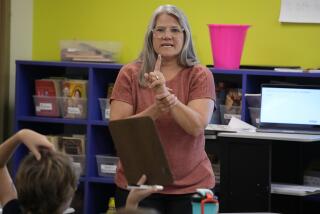Making It Add Up
- Share via
Nearly 30 years ago the Soviet Union launched its first Sputnik, a space shot heard round the world of education. Americans scrambled to review their science and mathematics curricula, and found them lacking. Now the scores of an international math test are forcing another review. The scores seem to put Americans behind the Japanese and virtually everyone else, and the question is why.
The test was conducted in 17 nations in 1982, but the first results were published only last month. American eighth-graders on the average scored lower than those from a dozen other industrialized nations. Americans’ average scores ranked above only those from Sweden, Thailand, Nigeria and Swaziland. Algebra and calculus tests of the top 5% of 18-year-olds showed Americans scoring lowest among participants from 10 countries.
Are schools in other countries doing things that American schools don’t do? The answer is yes, in two ways: national differences in school systems and therefore in educational achievements, and different approaches to teaching math.
Some countries, the United States among them, have comprehensive school systems that seek to reach as many students as possible. Other countries remain elitist. So the test may be comparing the incomparable, as one international education expert put it, measuring students of a system in which 75% of the students finish high school against others in which far fewer graduate.
Some countries have centralized education ministries that dictate curricula because they provide all the education money. The United States promotes local control that leads to diverse goals and curricula. Because there is no standard U.S. math curriculum, many Americans do not study calculus until they reach college. But the international test for 18-year-olds includes calculus.
Leigh Burstein, a UCLA statistics professor, says that Japanese students not only study calculus earlier than Americans but also learn math concepts earlier. They also learn to solve problems in a variety of ways. Both approaches give them an advantage in testing. Japanese students also work more with mathematical models, while much of American math teaching is “a textbooky kind of thing,” he added.
What to do? Kenneth J. Travers of the University of Illinois, who has worked with the testing project for 10 years, doesn’t think that the answer lies in requiring students to take more math before they graduate from high school. He wrote recently that “an important need is not more time to teach math but better use of the time presently available . . . . In Japan, where scores were 10 to 20 points above those of the United States, math topics receive focused attention, and each must be mastered before the students move on.”
“Finally, in a society in which technology abounds and calculators are nearly as common as ballpoint pens, the math classroom should welcome electronic innovation,” Travers said, adding that the use of calculators and computers could transform the math classroom “into a laboratory where honest-to-goodness exploration goes on.”
The message? A change here and a change there can add up to mathematics curricula that will equip today’s youngsters for their century--the 21st.
More to Read
Sign up for Essential California
The most important California stories and recommendations in your inbox every morning.
You may occasionally receive promotional content from the Los Angeles Times.










